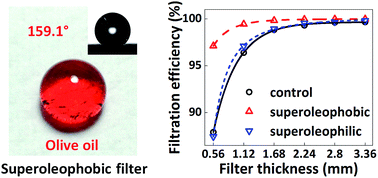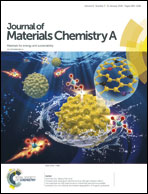Efficient removal of aerosol oil-mists using superoleophobic filters†
Abstract
Conventional filters for oil-mist filtration chiefly use fibrous materials, which have inadequate efficiency for small oil mists (e.g., size < 1 μm). Thicker filter mats are applied to increase filtration efficiency, but they not only consume more filter materials but also increase the energy cost due to increased air flow resistance. In this study, we have for the first time demonstrated a novel concept of improving the filtration efficiency for the separation of small oil mists from air without apparently increasing the air flow resistance. Using a commercial glass fibre filter as a model, we prepared a superoleophobic surface through a wet chemical coating method using a perfluoroalkyl acrylic copolymer as the material. The coating shows very little effect on the porous feature and air permeability of the fibrous filter. The superoleophobic treatment shows a considerable increase in the filtration efficiency. For the filter of thickness 1.12 mm, the filtration efficiency for small oil mists increases from 96.40% to 99.44%, whereas the pressure drop is increased by only 6% but the downstream oil mist content is reduced by 85%. For large oil-mists, the superoleophobic filter has almost 100% filtration efficiency with downstream mist subsided close to zero. A “bounce-collide-drain” mechanism was proposed to explain the improvement of the filtration performance. Such a novel concept may have great significance in the development of high efficiency, low energy consumption gas–liquid coalescing filters.



 Please wait while we load your content...
Please wait while we load your content...